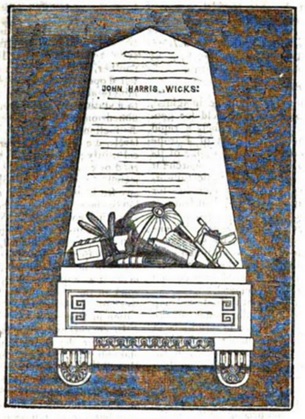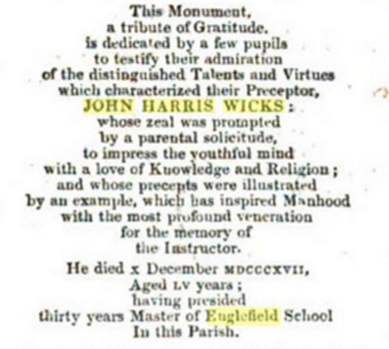Inspiring Pupils With A Love Of Learning
As part of our current exhibition, Educating Egham: Schooling in Egham, Egham Hythe, Englefield Green, Thorpe & Virginia Water, museum volunteer and researcher, Margaret Stewart investigates some interesting characters and their educational connections to the area.
The teacher who “Had The Art Of Inspiring His Pupils With A Love Of Learning.” A compliment any teacher would welcome, these words were used by 19th Century poet and satirical novelist Thomas Love Peacock to describe his teacher, John Harris Wicks.

Wicks had set up Wicks’s Academy in Englefield Lodge (also known as Englefield House), Middle Hill in 1787 for the sons of gentlemen. An annexe to the house served as a schoolroom but the boys also boarded. By 1790 the school was successful enough for him to be able to marry Harriet Dolby from Sunninghill.
The school is mostly known to us now because of his most famous pupil. Thomas Love Peacock joined Wicks’s Academy in 1792 at the age of seven. He stayed there for just six and a half years until his mother, living in Chertsey, could no longer afford the fees. He wrote his first letter to his mother in August 1792, which was sent with a postscript from Wicks complimenting the boy on having written it entirely unassisted. A later missive from February 1795 asking his mother to send him a shilling – or preferably two – contains his first known poem: an ode in memory of his friend Hamlet Wade who had recently died:
“Here lies interr’d, in silent shade,
The frail remains of Hamlet Wade;
Youth more promising ne’er took breath;
But ere fifteen, laid cold in death.
Ye young! Ye old! And ye of middle age!
Act well your part, for quit the stage
Of mortal life one day you must.
And like him moulder into dust.”
Looking back later Peacock reminisced that Wicks was “not much of a scholar” but he had “excellent classical and French assistants.” The letter including the epitaph reflected the classical emphasis in his education by referring to Mount Parnassus, the classical home of the Muses.
Wicks published a number of books, from which we can infer that he himself taught mathematics and book-keeping:
- 1797 – Book-Keeping reformed: or the method by double entry, so simplified, elucidated, and improved, as to render the practice easy, expeditious, and accurate.
- 1811 – The Merchant’s and Artificer’s Companion; and practical Guide to Accounts, containing a plain and intelligible Arrangement of such Tables, Rules, and Practical Illustrations, as will form the perfect Accountant, and give a clear Idea of the present improved Practice of the Counting-House, and what is absolutely useful to the Merchant and Artificer, upon a Plan which will be useful in Schools, and ease the labours of those who are concerned in the Education of Youth.
- 1817 – The Remembrancer, containing a selection of questions in … Arithmetic and English Grammar, etc.
The school continued to flourish until Wicks died in 1817 at the age of 55.
After his death, a monument was erected in Egham Church to mark his 30 years’ contribution to local education; plans were also made to distribute bread and clothing to the poor on his birthday.


The academy was reopened in February 1818 by the Rev Robert Baskett and Mr Joseph King with annual fees of 30-40 guineas a year and continued until approximately 1825. Their prospectus advertised that “The peculiar character of the studies is classical but great attention will be given to every useful pursuit that the elegant scholar who shall have made great attainments in polite studies may not be found wanting in that kind of learning which is indispensably necessary to the ordinary purpose of life.”
Margaret C Stewart
[1] Cameron, Kenneth Neill ed. (1961) Shelley and His Circle, 1773-1822, Volume 1. Harvard University Press.
[2] Limbird, J. (1838) The Mirror of Literature, Amusement, and Instruction, Volume 30. J. Limbird. https://books.google.co.uk/books?id=4_JZAAAAYAAJ&pg=PA137&lpg=PA137&dq=John+harris+wicks+englefield&source=bl&ots=ggmAyNnOAZ&sig=qgB5oDX54YDO5S0mrNw66FbmOJk&hl=en&sa=X&ved=0ahUKEwjK5oiFiZvYAhXiDcAKHSLBCbkQ6AEIOTAG#v=onepage&q=John%20harris%20wicks%20englefield&f=false [Accessed 30 April 2018]
